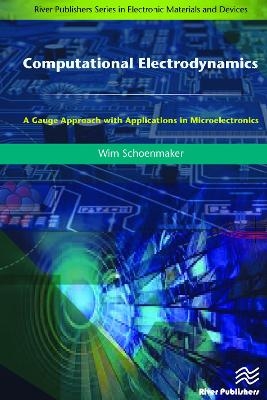
Computational Electrodynamics
River Publishers (Verlag)
9788793519848 (ISBN)
Technical topics discussed in the book include:
Electromagnetic Field Equations
Constitutive Relations
Discretization and Numerical Analysis
Finite Element and Finite Volume Methods
Design of Integrated Passive Components
Wim Schoenmaker
Preface; List of Symbols;
PART1: Introduction; The Microscopic Maxwell Equations; The microscopic Maxwell equations in integral and differential form; Conservation laws; Potentials and Fields and the Lagrangian; The scalar and vector potential; Gauge invariance; Lagrangian for an electromagnetic field interacting with charges and currents; The Macroscopic Maxwell Equations; Constitutive equations; Boltzmann transport equation; Currents in metals
Charges in metals; Currents in semiconductors; Dielectric and Magnetic media; Wave Guides and Transmission Lines; Transmission line theory; Classical Ghosts Fields; Energy Calculations and the Poynting Vector; The Geometry of Electrodynamics; Integral Theorems; Vector identities
PART 2: The Finite Difference Method; The Finite Element Method; The Finite Volume Method and Finite Surface Method; Finite Volume Method and the Transient Regime
PART 3: Simple Test Cases; Evaluation of Coupled Inductors; Coupled Electromagnetic-TCAD Simulation for High Frequencies; EM-TCAD Solving from 0-100 THz; Large Signal Simulation of Integrated Inductors on Semi-Conducting Substrates; Inclusion of Lorentz Force Effects in TCAD Simulations; Self-Induced Magnetic Field Effects, the Lorentz Force and Fast-Transient Phenomena; EM Analysis of ESD Protection for Advanced CMOS Technology; Coupled Electromagnetic-TCAD Simulation for Fast-Transient Systems; A Fast Time-Domain EM-TCAD Coupled Simulation Framework via Matrix Exponential with Stiffness Reduction
PART 4: Surface-Impedance Approximation to Solve RF Design Problems; Using the Ghost Method for Floating Domains in Electromagnetic Field Solvers; Integrating Factors for the Discretized Maxwell-Ampere Equation; Stability Analysis of the Transient Field Solver; Summary of the Numerical Techniques
| Erscheinungsdatum | 06.07.2017 |
|---|---|
| Reihe/Serie | River Publishers Series in Electronic Materials and Devices |
| Verlagsort | Gistrup |
| Sprache | englisch |
| Maße | 156 x 234 mm |
| Themenwelt | Mathematik / Informatik ► Mathematik |
| Naturwissenschaften ► Physik / Astronomie ► Angewandte Physik | |
| Naturwissenschaften ► Physik / Astronomie ► Elektrodynamik | |
| Naturwissenschaften ► Physik / Astronomie ► Mechanik | |
| Technik ► Elektrotechnik / Energietechnik | |
| ISBN-13 | 9788793519848 / 9788793519848 |
| Zustand | Neuware |
| Informationen gemäß Produktsicherheitsverordnung (GPSR) | |
| Haben Sie eine Frage zum Produkt? |
aus dem Bereich


